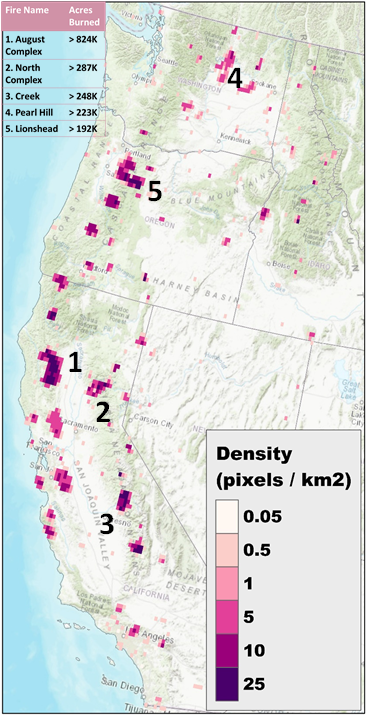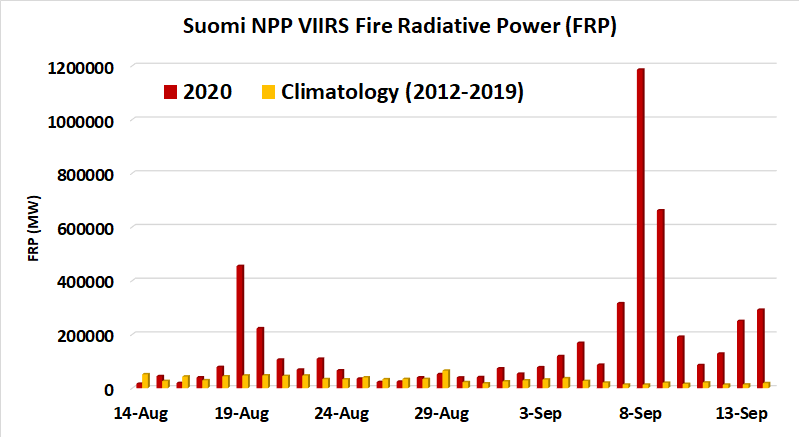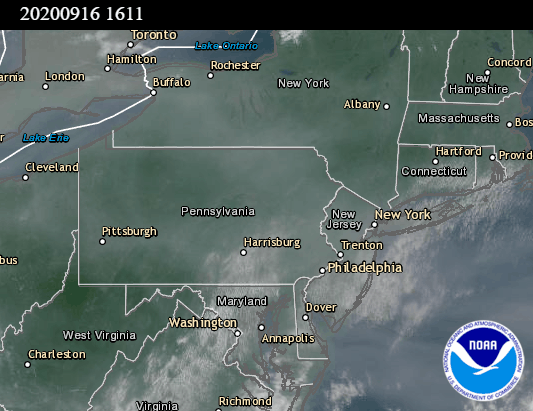
NOAA satellites follow the smoke journey
Figure 1. Fire pixel density (number of pixels per square kilometer) for August 14 – September 14, 20208 October 2020 - NOAA's polar-orbiting and geostationary satellites continuously monitor the Earth's environment acquiring records of environmental hazards including fires. The Suomi National Polar-orbiting Partnership (SNPP) has been orbiting the Earth since its launch on October 28, 2011, and has captured the blazing fires and smoke with the Visible Infrared Imaging Radiometer Suite (VIIRS) and Ozone Mapping and Profiler Suite (OMPS). These satellite instruments sense the heat from the fires to tell us about the fire's location and intensity and the reflected or absorbed radiation from the smoke to inform us about the smoke's composition, thickness and movement. The U.S. Environmental Protection Agency (EPA) defines air quality using different categories, ranging from good to hazardous based on the concentration of particles smaller than 2.5 micrometers in median diameter, a size small enough to enter the human respiratory system and cause lung tissue damage and cardiovascular disease. These particles are referred to as PM2.5. The fires that are raging in California, Oregon, and Washington are unprecedented in terms of their duration, their intensity and the area burned. As you can see in these Suomi NPP VIIRS measurements taken from August 14 to September 14, 2020, a number of fires are burning across the western U.S., but the most intense burning is associated with the August Complex, North Complex, and Creek fires. These three fires in California have so far consumed more than 824,000, 287,000, and 248,000 acres respectively and are listed as the top three fires by an interagency incident information system website. To characterize fires, satellites rely on an important measurement called fire radiative power. Fire radiative power, or FRP, is a satellite derived measurement of the amount of heat released by a given fire in megawatts. And for the 2020 fires, the FRP is 80% higher than the average FRP during the same time period for the years 2012 through 2019. The highest FRP value for all fires in the three western states occurred on Sept 8, at about 1.2 million megawatts. "Fires of this intensity can release 20 to 40 tons of particulate matter into the atmosphere in one second," said Dr. Shobha Kondragunta, a physical scientist at NOAA/NESDIS/STAR. For perspective, the average FRP for this day during the years 2012 to 2019 is 0.013 million, and for the same period, the highest value was only 0.065 million megawatts. Poor air quality is a significant risk to public health. According
to the EPA, 34,000 premature deaths a year could be prevented if the
nation could lower annual levels of particle pollution by 1 µg/m The NOAA NESDIS Center for Satellite Applications and Research
(STAR) converts the satellite-derived aerosol optical depth (a
quantitative measure of column aerosol loading) into surface PM2.5
using a statistical regression algorithm. As the smoke from western
U.S. fires began its journey to the east, crossing the Atlantic
Ocean and reaching northern Europe, it stayed aloft. The series of
PM2.5 maps derived for this time period show that on September 8,
when FRPs were at their highest at about 1.2 million megawatts,
PM2.5 concentrations were also high: at unhealthy (> 55.5 µg/m Smoke from fires burning in northwest Colorado also stretched
east and mixed with the smoke from the western U.S. fires. The
smoke region extended over the whole continental U.S. and took
on the shape of a dinosaur. People on social media started referring
to the smoke-covered region as smokesaur. Interestingly, the PM2.5
map for September 14 shows that PM2.5 values were in a good (< 15 µg/m 
Time series of maps of PM2.5 estimates from Suomi NPP VIIRS illustrating smoke concentrations and transport of smoke from the west to east. Light blue shaded areas are regions where aerosol optical depth is not available (due to clouds, glint etc.) to derive PM2.5As the smoke continued to move into the mid-Atlantic states, colleagues at the University of Maryland Atmospheric and Oceanic Science (supported by Maryland Department of Environment and National Institute of Standards and Technology) and the NOAA Air Resource Lab coordinated with the NOAA/NESDIS STAR aerosol team to design an instrumented aircraft flight path to directly measure the smoke on September 16. In addition to the VIIRS aerosol products, the OMPS aerosol index and the GOES-16 satellite's 10-minute visible and aerosol imagery movies provided evidence for the location of smoke. Based on these NOAA satellite imagery and other sources of information, the University of Maryland Department of Atmospheric and Oceanic Science joined with NOAA's Air Resource Lab team to fly in a Cessna aircraft to make smoke optical and chemical measurements that will help the scientists understand the aerosol and ozone formation processes. This team, led by Dr. Xinrong Ren, did an aircraft spiral northeast of Baltimore, Maryland, and found the smoke between 1.5 and 2.5 miles. Reporting a mean concentration of 62 µg/m3 and only trace amounts near the surface, the AOSC team validated the VIIRS satellite-derived PM2.5 map that showed the conditions on the ground were good (PM2.5 < 15 µg/m3). "We were really pleased to get the satellite images," said
Russ Dickerson, professor of atmospheric chemistry at the University
of Maryland. "They allowed Graduate student Hannah Daley to fly
right to the dilute smoke plume, profile up through it, and
measure its optical and chemical properties. It was too high an
altitude to pose a hazard to the health of people on the East
Coast, but it shows that the fires had a massive impact on the
atmosphere over a broad area." Having two VIIRS instruments in orbit (VIIRS also flies on the NOAA-20 satellite), and having adapted the PM2.5 algorithm to run on a blended Suomi NPP and NOAA-20 VIIRS aerosol optical depth product, has helped NESDIS/STAR to support the user community by minimizing gaps due to clouds and optimizing the available VIIRS PM2.5 information. The suite of aerosol imagery distributed to users via websites and social media facilitated the public warnings and watches of poor air quality. 
Surface PM2.5 concentrations on September 14, 2020 predicted by the Community Multiscale Air Quality (CMAQ) model, which uses the NESDIS Blended Global Biomass Burning Emissions Product (GBBEPx) to represent wildfire sources"Satellite data are essential for forecasting air quality during wildfires," said Dr. Daniel Tong, associate professor of atmospheric chemistry and aerosols at George Mason University and a research scientist at NOAA's Air Resource Lab. The National Air Quality Forecast Capability, operated by the National Weather Service, relies on satellite products, including fire detection and emission estimates, to drive its models. Federal and state agencies use these numerical forecasts to support their own missions, including issuing local air quality alerts. Credits: |
|

